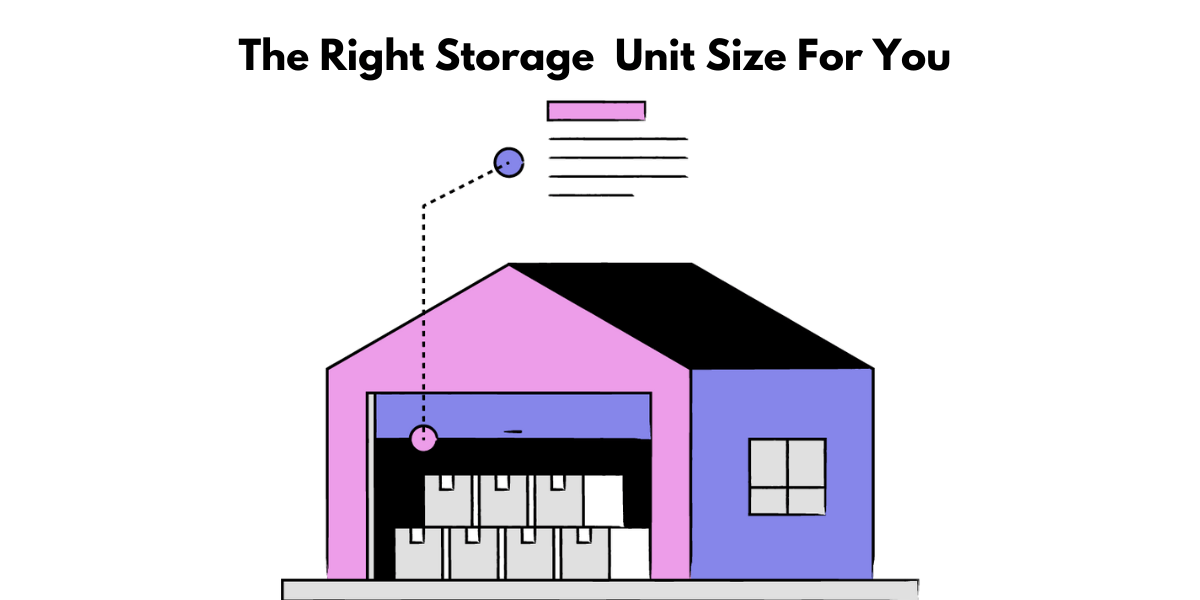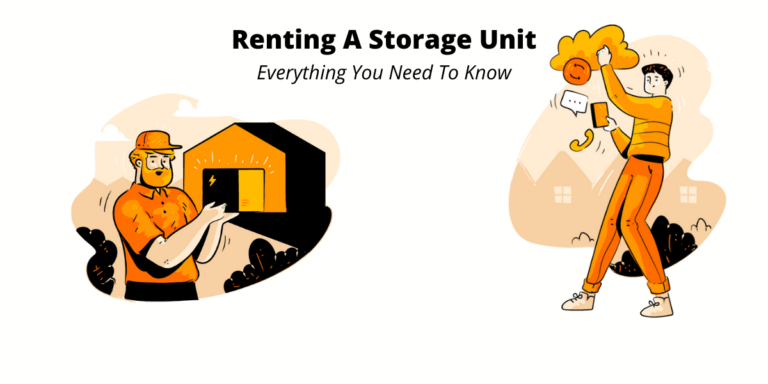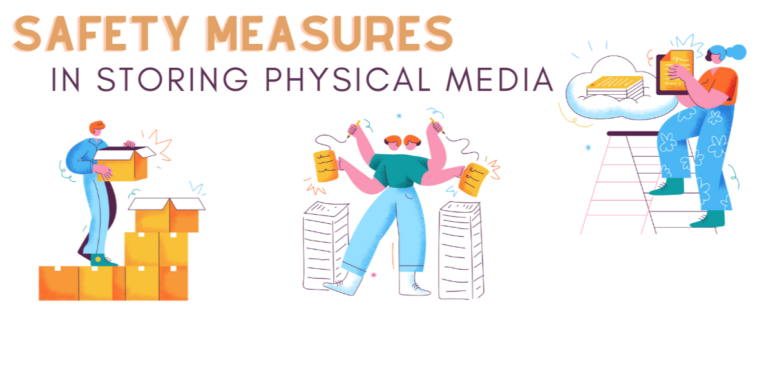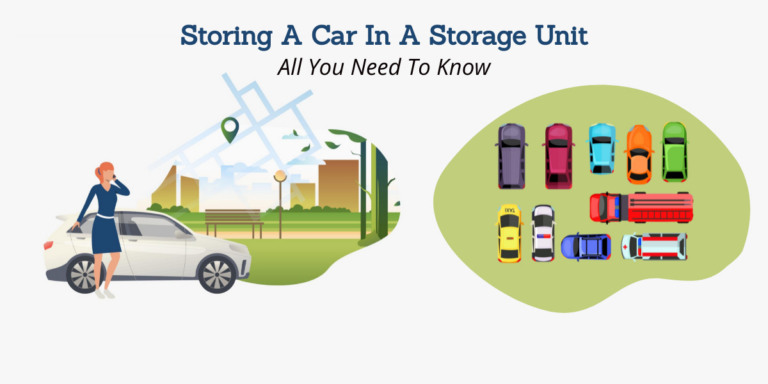Storage Unit Sizes: What you need to know to make sure it’s the right one for you
Storage Unit Sizes
When it comes to storage units, there are a variety of sizes and options available. But how do you know which size is right for you?
What are the standard storage unit sizes?
Here’s a quick guide to help you choose the perfect storage unit size for your needs:
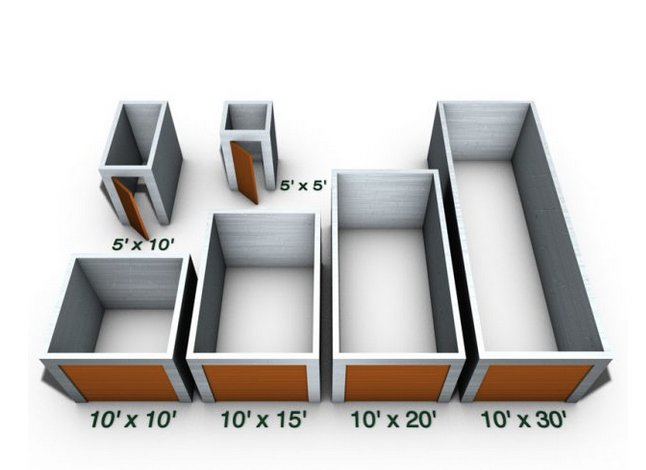
5’x5′ storage unit
A 5’x5′ storage unit is a self-storage unit that is 5 feet wide by 5 feet long.
The size of a 5’x5′ storage unit depends on your chosen storage facility. For example, at some facilities, a 5’x5′ unit may be large enough to fit one or two standard-sized chairs or tables. Other facilities may offer larger units that accommodate larger items such as couches or beds. It is important to check with your particular facility before renting a space to determine what fits in the designated size you’re considering.
5×10 storage unit
A 5×10 storage unit is a type of self-storage unit that measures 5 feet wide by 10 feet long.
The size of a 10×5 storage unit depends on the type of storage facility and may vary from one facility to another. Generally, most units are around 500 square feet, with an additional 100 square feet for every foot added to the width. For example, a 10×15 storage unit would be roughly 1,500 square feet. The exact dimensions will be specified when renting or leasing a particular unit.
5×15 storage unit
A 5×15 storage unit is a type of self-storage facility that offers spaces measuring five feet by fifteen feet.
The size of a 5×15 storage unit is relatively small compared to other storage units, such as 10×15 or 15×25 units. It can accommodate the needs of individuals or small businesses looking to store household items, furniture, appliances, or other personal belongings. The dimensions for this type of unit are typically expressed in feet (5′ x 15′).
10×10 storage unit
A 10×10 storage unit is a type of self-storage unit that measures 10 feet by 10 feet. It is large enough to store various items, from furniture and appliances to documents and personal belongings.
When deciding on a storage unit size, it is important to consider what you will be storing and how long you will need to store it. If you are unsure of the size you need, the storage facility may have a size guide that can help you determine the right unit for your needs.
10×15 storage unit
A 10×15 storage unit is a self-storage unit that is 10 feet wide and 15 feet long.
The size of a 10×15 storage unit depends on the type of storage unit you are renting. Generally, a 10×15 storage unit can hold up to 1,500 cubic feet of items. This size is typically sufficient for storing household items such as furniture, appliances, and clothing. Many facilities also offer larger sizes, such as 10×30 units which can hold up to 3,000 cubic feet of items.
10×20 storage unit
A 10×20 storage unit is a self-storage unit that measures 10 feet wide by 20 feet long. It can accommodate a variety of items, such as furniture, appliances, boxes, and other household items.
When deciding what size storage unit you need, it’s important to consider how much stuff you have and what kind of items they are. You’ll need a larger unit if you have many large items, such as furniture. You can get away with a smaller unit if you have mostly small items, such as boxes.
10×30 storage unit
A 10×30 storage unit is a type of large storage units that measures 10 feet wide by 30 feet long. It can hold approximately 300 cubic feet of goods, equivalent to about two rooms’ worth of furniture.
This size unit is perfect for storing the contents of a three-bedroom home, including appliances, boxes, and small furniture items. If you’re looking for a storage unit to hold the contents of a four-bedroom home, you may want to consider a larger size, such as a 10×40 storage unit.

How to choose the right storage unit size for your home
There are many factors to consider when choosing the right storage unit size for your home. The type of items you need to store, the amount of space you have available, and your budget are all important considerations.
Here are a few tips to help you choose the right storage unit size for your needs:
Step 1: Perform an inventory of your belongings
Performing an inventory of the items you want to store can help you choose the right storage unit size for your home by allowing you to measure and identify the smallest space each item can fit into.
By knowing exactly what is going into your storage unit, you can more accurately estimate what size unit will suit your needs. This will help ensure that everything fits properly when it’s time to move it into storage.
Step 2: Double-check your home storage options
If you’re considering renting a storage unit, you first need to figure out what size will best suit your needs. Here’s a step-by-step guide to help you choose the right storage unit size for your home.
Step 3: Calculate your space
When calculating the size of the storage unit you need for your home, it’s important to consider a few factors. First, consider how much space you have available. You may need a larger unit if you have a lot of stuff. Second, think about how long you’ll need to store your belongings. If it’s just for a short-term move, you may be able to get away with a smaller unit. Finally, consider what type of items you’ll be storing. If you have large furniture or appliances, you’ll need a unit to accommodate them.
Step 4: Pick a small, medium, or large storage unit size
Now that you know what kind of things you need to store and how long you need to store them, it’s time to pick a size. Small storage units are typically 5’x5′ or 5’x10′, medium units are 10’x10′ or 10’x15′, and large units are 15’x15′ or larger. To determine what size is right for you, list the items you need to store and measure them. Once you have your measurements, use our Storage Unit Size Guide to find the right size for your needs.
Regarding storage units, size matters. If you pick a unit too small, you’ll have a lot of wasted space. If you pick a unit too large, you’ll end up paying for space you don’t need. To find the perfect storage unit, list the items you need to store. Then, measure the items and use our Storage Unit Size Guide to find the right size for your needs.
Step 5: Research specific measurements for different unit sizes
Researching measurements for different sizes of storage units can help you determine what size you need and save money by choosing a big enough unit to store your larger items but not so huge that there is leftover space.
However, each storage facility has recommendations for what will fit specific units, so it’s important to check with individual companies in your area for their specific measurements.
Step 6: Check customer reviews for each storage unit size available
When looking for a storage unit, it’s important to read customer reviews to understand what others think about the size you’re considering. This will help you ensure that your storage unit size is the right one for your needs. There are a few things to remember when reading storage unit reviews. First, take note of the reviewer’s location. If they’re in a different city or state than you, their experience may not be relevant to your situation. Second, pay attention to the reviewer’s needs. They may need a bigger unit than you if they have a lot of stuff to store. Finally, consider the reviewer’s level of satisfaction. If they’re happy with the size of their unit, you will likely be too.
Step 7: Consider the budget for your new storage unit
When budgeting for a new storage unit, it is important to consider the price difference between small and medium units. You should also consider any additional fees or costs associated with renting a larger unit.
When budgeting for a new storage unit, it is important to compare prices between different providers to find the best deal possible. Additionally, you should consider any pro tips the storage facility provides regarding what will fit in their units and how much space you need for your belongings.
Step 8: Evaluate the safety and security needs of your new storage unit
When choosing a storage unit, it is important to consider safety and security needs. Companies typically offer features such as 24-hour video surveillance, electronic access control systems, and security fencing around the facility.
It is also important to consider any special needs or requirements that may affect the safety and security of your items in storage. For example, suppose you plan on storing highly sensitive documents or items prone to moisture or humidity damage. In that case, you may need a climate-controlled unit with dehumidifiers and air conditioning.
Step 9: Ask questions if necessary
If you have any questions about the sizes of storage units, don’t hesitate to ask the experts. They can help you choose the right size for your needs.
What to consider when choosing between different storage unit sizes
When looking for a storage unit, choosing the right size for your needs is important. Here are some things to consider when making your decision:
Capacity
Extra Space Storage offers a wide range of sizes of storage units, ranging from 2×2 lockers to large-scale warehouse units for commercial needs.
Size
When choosing between different sizes of storage units, it is important to consider the number of items you need to store and any major appliances that need to be stored. For example, a 10′ x 10′ unit is ideal for storing the contents of a two-bedroom apartment, while a 10′ x 15′ unit can accommodate more items or major appliances.
On the other hand, if you need more space than what a standard 10′ x 10′ or 10′ x 15′ unit can provide, then you may want to look into renting a larger warehouse space for commercial use. Additionally, some facilities may offer smaller lockers suitable for storing smaller items like documents or clothing.
Costs
The average storage unit size is approximately 10 x 10 feet (or 100 square feet). These medium-sized units cost around $160 per month and can often fit belongings from 1 to 3 bedrooms.
CubeSmart offers 11+ different size options ranging from 5 x 5 feet up to 20 x 20 feet, with prices ranging from $40 to $200 per month.
Simply Self Storage offers 8+ different size options ranging from 5 x 5 feet up to 20 x 40 feet, with prices starting at $39 per month for a 5’x5′ unit and going up to $119 per month for a 20’x40′ unit.
U-Haul offers 9+ different size options ranging from 4’x4′ up to 16’x20′ with prices starting at around $35/month and going up to over $200/month, depending on the unit size chosen. Life Storage also offers 9+ sizes ranging from 4’x4 ′ to 25′x25′.
Size options
The different size options for storage units offered by Extra Space Storage include the following:
- 2×2 locker – ideal for small documents, clothing, and household items.
- 5×5 – large enough to store household furniture or other bulky items.
- 5×10 – large enough to store larger pieces of furniture or multiple bins full of belongings.
- 5×15 – ideal for storing large pieces of furniture and multiple boxes full of personal items.
- 10×10 – large enough to fit a car or motorcycle and other belongings.
- 10×15 is great for storing larger vehicles like boats or RVs along with other possessions.. 10×20 is perfect for storing big appliances like refrigerators and washing machines. 10×25 – ideal space for commercial use, such as warehouse storage. 10×30 – largest available size at most locations, suitable for businesses that need lots of extra space.
Heights
The standard height of a storage unit tends to be around 8 feet tall, but some facilities offer 10-foot ceilings to accommodate unusual storage needs.
To reduce the cost to consumers, some cities have introduced reduced-height storage units that stack more units in the same facility with the same square footage floor space but for a lower cost.
Accessibility
When choosing between different sizes of storage units based on accessibility, it is important to consider the features of each size. Smaller units can be either interior or exterior, with the former offering climate control options and the latter providing drive-up access. Larger units are almost always exterior without climate control, but they may have additional features such as loading docks or forklift access.
On the other hand, smaller units typically have lower monthly rental rates than larger ones due to their limited space. Additionally, smaller units may not be able to accommodate certain items like furniture or large machinery due to their limited size and inability to control the climate in most cases. Conversely, larger units usually cost more per month but offer more space for larger items like vehicles or furniture sets.
Security
Some facilities offer units as small as 2×2 lockers, while others have large-scale warehouse storage for commercial needs. Both types of units provide varying levels of security depending on the facility and its security measures.
However, it is important to note that smaller units typically have fewer security features than larger ones. For example, smaller units may not have surveillance cameras or electronic access card readers. Additionally, smaller spaces are more likely to experience higher temperatures due to less air circulation than larger spaces. Therefore it is important to consider these factors when choosing between different sizes of self storage and factor in any potential associated risks.
Lighting
The larger storage units have more space and may offer more lighting options, such as overhead lights or windows that provide natural light.
The smallest self storage unit size, a 9–25 square foot locker, generally does not have enough space or lighting options to store items comfortably. It is best suited for items that do not require much space or light, such as boxes and an end table.
Climate control
When choosing between different storage unit sizes, consider the climate-controlled option for items that require a more temperature-controlled environment, such as electronics, artwork, antiques, and heirlooms.
Exterior units typically do not offer climate control, while interior units often do. Additionally, smaller units are usually available with interior climate control, while larger units are not as common with drive-up access (with climate control). Security features are typically the same across all sizes of storage units at a given facility.
Equipment
When choosing between different storage unit sizes, you must consider the size of the items you wish to store. For example, a 10’x10′ unit may be sufficient for storing smaller items, such as furniture or household decorations. A 15’x15′ unit would be better suited for larger appliances or furniture sets.
When comparing units of different sizes, it is important to consider how much space you need and how much space your belongings will take up. For example, if you only store small items, then a 10’x10′ unit may be sufficient, but if you need more room, a 15’x15′ unit would likely offer more usable space than its smaller counterpart.
Shape
The shapes of storage units can vary depending on the facility. Common shapes include lockers, garages, and drive-up units.
The size and shape of a storage unit can affect its cost and availability. For example, lockers are generally smaller and less expensive than drive-up units or garages.
Length
When choosing between different storage unit sizes, it is important to consider the length factor. Most units range from 3 x 3 feet (small) to 10 x 30 feet (large), with some designed for oversized recreational vehicles up to 50 feet long.
Short units are sometimes standard in some cities, so verify with your chosen company what size best suits your needs.
Width
When choosing between different storage unit sizes, it is important to consider the width factor. The 10′ x 10′ and 10′ x 15′ units are the most common sizes and provide enough space for most household items. The 5′ x 15′ units offer extra depth and are ideal for storing longer items such as furniture or appliances.
Depth
The depth of different storage unit sizes varies depending on the facility. Typically, standard-size units are between eight and ten feet high, while large cities like New York offer reduced-height units that stack more units in the same facility.
Standard-size units have a depth of between 12 and 20 feet, while reduced-height units typically have a depth of about six to eight feet. This gives renters more space for their belongings at a lower cost than traditional storage unit sizes.

FAQs
Here are some of the most frequently asked questions about storage unit sizes:
How much does a storage unit cost?
The average storage unit size is 10 x 10 feet (or 100 square feet). These medium-sized units cost around $160 per month, which is higher than the average price of a 5 x 5 self-storage unit, which costs around $100 per month. However, it is lower than the average price of a 12 x 12 self-storage unit, which costs around $300 per month.
Can a car fit in a 10×15 storage unit?
Yes, a car can fit in a 10×15 storage unit. The smallest cars on the market may be able to fit into this size of the unit, but most vehicles — including cars, SUVs, vans, and even some pickup trucks — will need a larger space, such as a 10×20 or 10×25. Larger vehicles may require an even larger space, such as a 10×30.
What is the smallest storage unit you can rent?
The smallest storage unit you can rent is typically a 5×5. This is just big enough to fit a few boxes and some small furniture items. This is a great option if you’re looking for something to store seasonal items or extra belongings. If you need to store larger items, you may want to consider a larger unit.
Can a couch fit in a 5×5 storage unit?
Couches can fit in a 5×5 storage unit. While it is unlikely that sectionals will fit, smaller couches should be able to fit into the space provided.
Large pieces of furniture such as love seats, sectionals, and desks are not likely to fit into a 5×5 unit due to their size and weight. Nightstands or hope chests may be too large for this storage space.
- Storage Unit Sizes: What you need to know to make sure it’s the right one for you - January 23, 2023
- A Complete Guide on Safe and Secured Motorcycle Storage - November 19, 2022
- 10 Creative Ways a Self-Storage Unit Help Home Stagers - June 5, 2022

